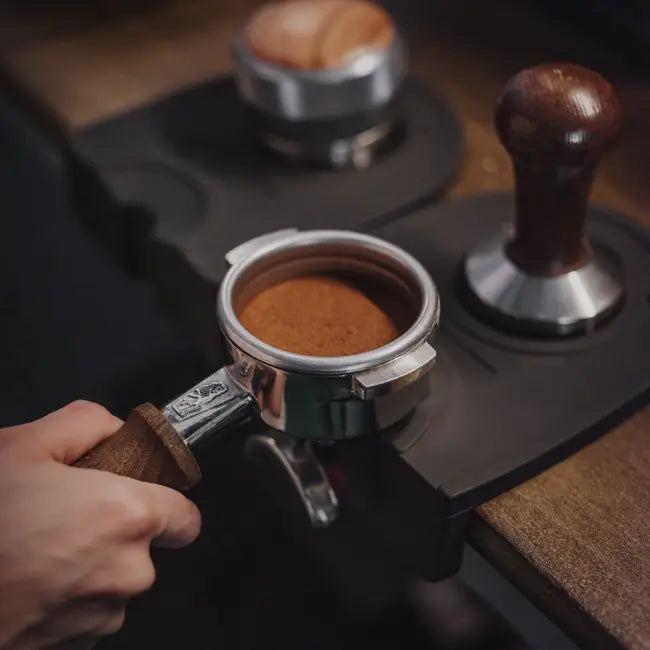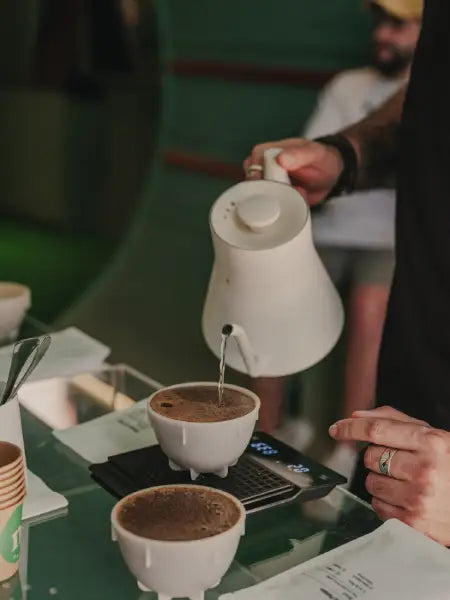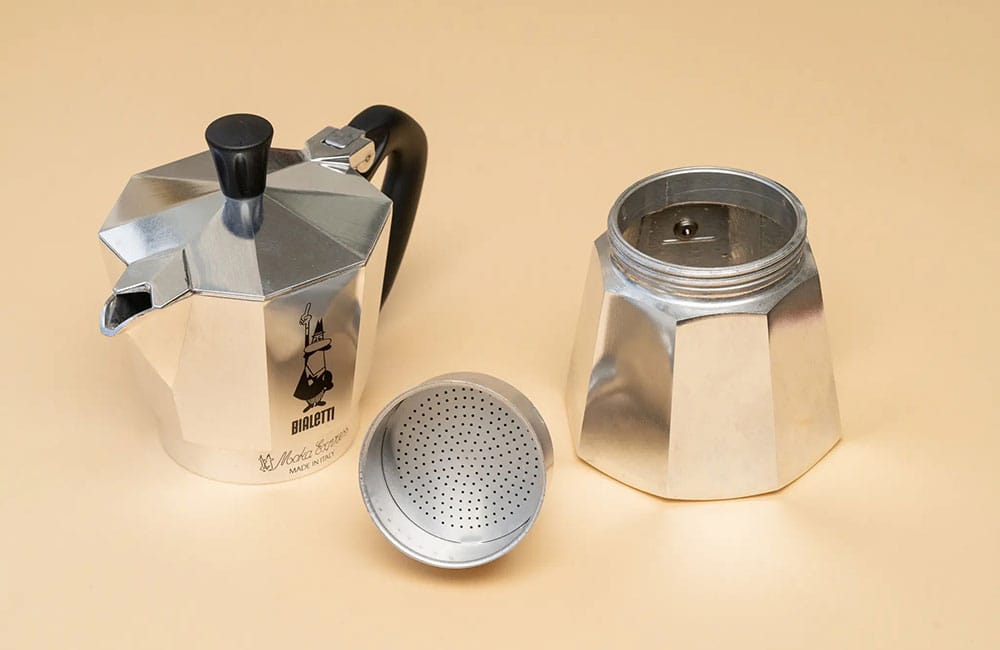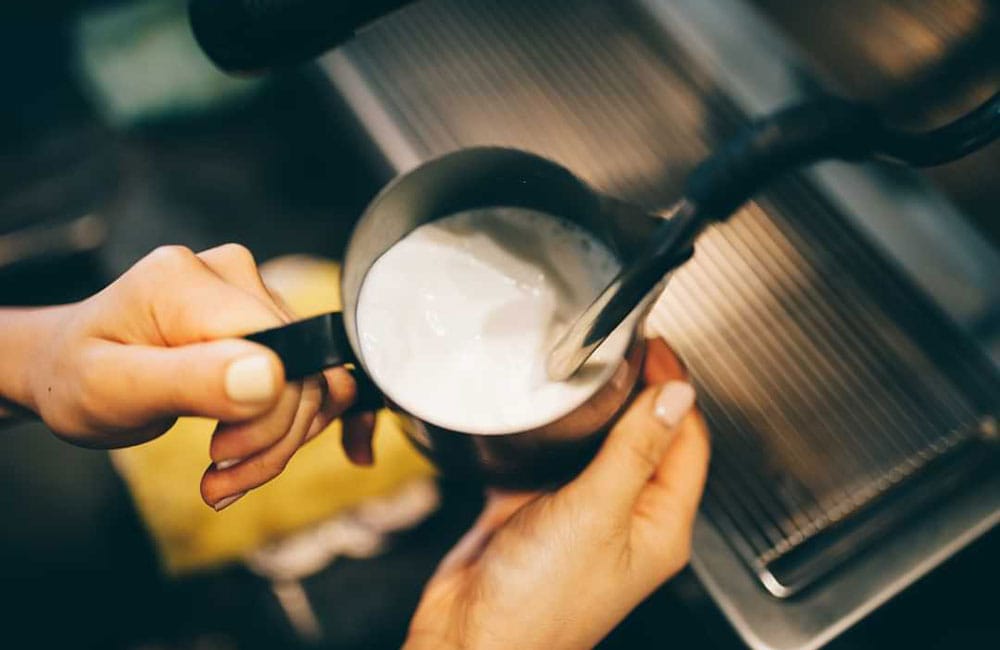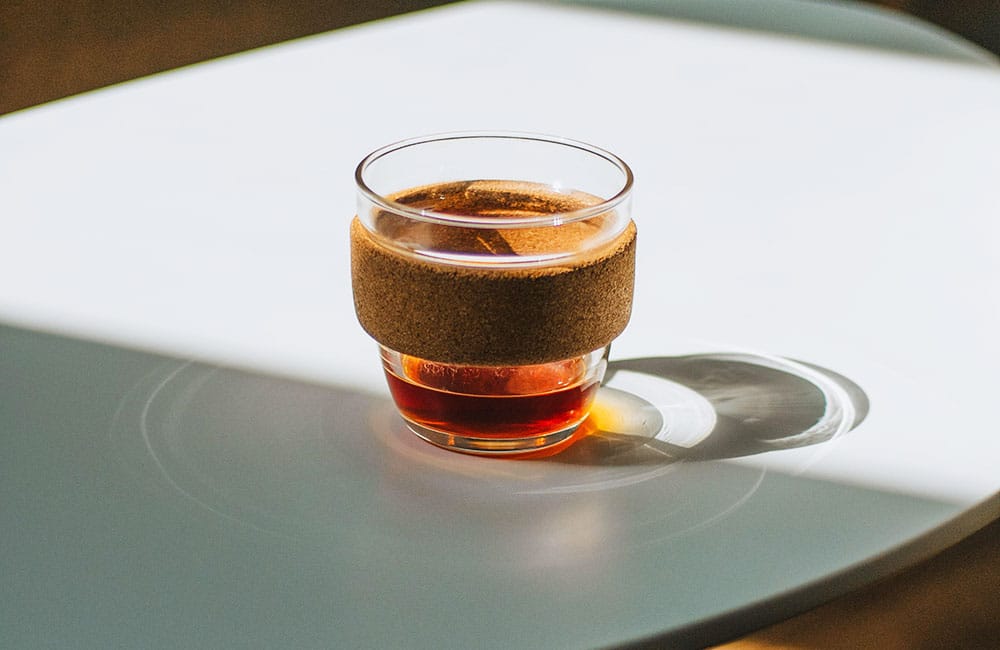¿Cómo hacer el café perfecto en cafetera italiana?
La tradicional cafetera italiana, también llamada moka, greca o macchinetta, sigue brindando un gran servicio en todas nuestras cocinas. Es un diseño que no pasa de moda, ya que se ha convertido en un icono cuando de café se trata.
No necesita actualización, ya que están elaboradas a la perfección para que cumplan con su cometido.
Por ello, ni las cafeteras más sofisticadas que han surgido a posteriori, ni las súper automáticas y mucho menos las cafeteras manuales de filtro que han surgido últimamente, han podido acabar con su existencia, ya que cada método de preparación da como resultado un tipo de bebida/café con matices diferentes.
La cafetera italiana posee un mecanismo muy sencillo y el café que se prepara en ella resulta de verdadera calidad, siempre y cuando se use café de especialidad y una receta de preparación correcta.
Ese es el secreto de su permanencia en el tiempo.
Origen de la cafetera italiana

Alfonso Bialetti fue el inventor de la cafetera italiana
La cafetera italiana siempre se ha considerado como un invento muy revolucionario, que no pierde vigencia.
Su origen data de la década de los años 30 del siglo pasado, cuando en Italia se comenzaron a perfeccionar las máquinas de expreso para darle un uso profesional.
Pero los fabricantes se dieron cuenta de que faltaba un aparato de utilización casera para la preparación del café. Debía tener la suficiente calidad para que toda la familia tuviera la oportunidad de disfrutar de un delicioso café hecho en su cocina.
La idea despertó en el ingeniero Alfonso Bialetti, la motivación de diseñar y patentar su revolucionaria cafetera, en el año 1933. La bautizó como Moka Express, elaborada perfectamente en aluminio, siguiendo los patrones y estilos de la época. El diseño bebe del Art Déco y se ha mantenido en el tiempo con variaciones menores.
Su invento revolucionó el mundo gastronómico, creando una gran aceptación en todos los hogares italianos, quienes sin dudarlo adquirieron en masa la máquina creada por Bialetti.
¿Cómo funciona la cafetera italiana?

Corte visual del funcionamiento de la cafetera italiana moka
En cuanto al funcionamiento de la cafetera italiana, resulta muy sencillo y practico gracias a que presenta un diseño de ingeniería muy simple, cuya aplicación es perfectamente manejable en el ámbito doméstico.
Para su uso, es importante saber que la cafetera está dividida en tres partes principales.
La primera la conforma una base o cámara de depósito para el agua.
La segunda es el cacillo/filtro de metal donde se pone el café molido.
Y la tercera y última es una cámara superior con forma de jarra con su respectiva tapa, que es donde aparece el café una vez extraído.
Adicionalmente, cuenta con un filtro muy fino y una goma en su parte inferior. Cuando se le aplica calor a la cafetera, previamente preparada con agua y café molido, la temperatura sube, el agua se evapora.

Cafetera italiana moka en funcionamiento
Llega un momento en que este vapor tiene la fuerza suficiente como para empujar al agua hacia arriba y a través del café molido para realizar la famosa extracción express.
El agua caliente sube atravesando el cacillo de café molido para infusionarla y seguir elevándose por los conductos, pasando por los filtros, continuando su recorrido hasta la chimenea de la jarra superior, saliendo luego por su abertura y procediendo a llenar la cámara recolectora.
Cafetera Italiana Bialetti

Alfonso Bialetti, el ingeniero que desarrolló la cafetera italiana
Alfonso Bialetti fue el ingeniero que desarrolló la cafetera italiana y el fundador de la empresa que lleva su nombre. Pero no todas las cafeteras moka que encontramos en el mercado llevan su nombre.
Actualmente, en el mercado se pueden encontrar un buen número de cafeteras que poseen el mismo mecanismo, aunque con diferencias menores de toques estéticos, adaptaciones de cada fabricante.
Cabe señalar que la propia cafetera italiana Bialetti, la original, también ha actualizado su catálogo. Ha sido renovada a través de pequeños toques, sobre todo su modelo Moka Express original. Se han usado otros colores que la hacen muy estética debido a los detalles decorativos.
Las cafeteras Moka tienden a clasificarse según el número de tazas que puedan llenar y que suelen variar de 1 a 8 tazas.
Disfruta del café de temporada, visita nuestra tienda
¿De aluminio o de acero inoxidable?
La Bialetti original y las que han surgido como descendientes son cafeteras de aluminio, un material que conduce muy bien el calor, y poseen un mango o asas de baquelitas, un plástico resistente que evita cualquier tipo de quemadura.
Sin embargo, no hay discusión en que las cafeteras de acero inoxidable resultan las mejores por ser eternas, pues su resistencia permite que pasen de generación en generación completamente intactas.

Cafetera italiana de aluminio y de acero inoxidable
¿Qué café usar para cafetera italiana?
La calidad del café es un elemento fundamental si se quiere que la bebida resulte agradable al paladar.
Lo ideal para realizar café en la cafetera italiana es usar perfiles de tueste como los que se usarían para una máquina espresso. Se recomendaría usar perfiles dulces y achocolatados, bien balanceados, con cuerpo y con una acidez baja.
Es importante que la acidez sea baja/media ya que la moka italiana acentúa la acidez, con lo cual debemos intentar balancear nuestra extracción para obtener un resultado equilibrado y complejo.
En nuestra tienda de café online puedes usar el filtro de cafetera italiana.
Todos los cafés que recomendamos para “espresso” también te darán un buen resultado. Los que recomendamos para “filtro/espresso” darán un buen resultado, pero estos cafés suelen tener más sabores afrutados y acidez.
La realidad es que todo café puede hacerse en una cafetera italiana. Si eres principiante, mejor comienza ciñéndote a estas directrices. Pero si ya eres un cafetero más avanzado, puedes lanzarte a probar cosas nuevas y experimentar.

Distintos molinillos para sacar todo el partido a tu café
Se sugiere, dentro de las posibilidades de cada usuario, invertir en un molinillo de café, esto permite moler el café en casa antes de su preparación, pero si eso no es posible, mejor pedir siempre una molienda específica para este la cafetera moka.
La molienda es un aspecto importante, ya que se necesita un punto de molido medio/medio-fino, que no sea ni muy fino ni muy grueso. En el caso de comprar el café ya molido, lo ideal es buscar una molienda específica para las cafeteras italianas.
¿Cómo preparar una cafetera italiana?
- Si se va a usar una cafetera italiana por primera vez se recomienda separar todas las piezas, enjuagarlas con agua tibia sin usar detergente y luego secarlas. También se recomienda elaborar un primer café que luego será desechado antes de degustarlo, por ser la primera vez.
- Esto se hace con el fin de eliminar cualquier sabor que pueda tener por ser nueva, porque lo que se pretende es curar su interior.
- En cuanto a la preparación del café en una cafetera italiana, es importante usar un café molido que no quede ni tan fino ni tan grueso, luego, llena el filtro usando dicho café hasta su nivel sin presionarlo.
- Generalmente, para las cafeteras italianas de 4 a 6 tazas tienden a usarse 20 gramos de café, pero realmente hay que llenar el cacillo hasta arriba.
- Luego debes rellenar con agua la base hasta debajo de la válvula, el agua no debe sobrepasar el nivel y el filtro no debe quedar flotando.
- Es conveniente calentar primero el agua. Esto lo puedes hacer con un cazo, una kettle o en la misa greca de la cafetera.
- Cuando el agua esté caliente, introduce el filtro con el café, cierra la cafetera, colócala en el fuego y déjale la tapa abierta.
- Al comenzar el café a salpicar, baja la tapa y retira la cafetera del fuego, acuérdate de remover el café antes de servirlo, ya que la primera parte de la extracción y la última no son iguales y se requiere homogenizarlo.
- Puedes poner la base de la cafetera italiana en agua fría para detener la extracción.
Se recomienda mantener siempre limpia la cafetera, es decir, lavarla inmediatamente después de cada preparación. De esta manera eliminamos todos los residuos y aceites que se pudieron haber adherido en su interior.

Una molienda correcta es muy importante para hacer café correctamente en una cafetera italiana
Cafetera italiana de inducción
Las cafeteras italianas de aluminio no funcionan en placas de inducción, y las de acero inoxidable tampoco funcionan todas.
Hay un pequeño truco para saber si una sartén u olla funcionará en una placa de inducción. Se trata de usar un pequeño imán y ver si se adhiere a la superficie de sartén u olla.
Si es así funcionará en la placa de inducción, en caso contrario no lo hará. Esto se debe a que las placas de inducción utilizan un sistema de imanes y resistencias para detectar el utensilio y calentarlo.
Podemos utilizar este mismo truco para saber si nuestra cafetera de acero inoxidable funcionará o no (las de aluminio no lo hacen).
En caso de que no se adhiera el imán a la superficie y que no funcione deberemos optar por comprar una cafetera italiana de inducción. No tienen por qué ser más caras, puesto que una cafetera de inducción puede utilizarse con cualquier fuego.
Equípate con nuestros complementos, visita nuestra tienda
¿Por qué no sube el café?
Pueden ser varias cosas. Lo más probable es que el café que estés usando tenga una molienda demasiado fina y con lo cual el café no suba ya que ofrece demasiada resistencia al agua.
También puede ser que tengas demasiado café o que el café esté prensado (no se debe prensar el café en la moka italiana). Puede ser que tengas poca agua en el depósito, o ninguna.
También podría ser que el conducto o filtro por el que sube el café se encuentra calcificado o bloqueado, esto impide que el agua suba hacia la parte superior de la cafetera.
Además, si observas que tu café no sale, es porque tal vez la cafetera tiene algún tipo de fisura, lo cual significa que quizás pierde vapor por la rosca o a través de la junta, lo recomendable es enfriarla, apretándola bien por si está mal cerrada y colócala de nuevo en el fuego.
Si sigue perdiendo vapor, puede ser que la junta de goma se haya dañado y debes sustituirla.
¿Por qué se queda agua?
Cuando el filtro de tu cafetera ha acumulado demasiada suciedad, no permite que el agua pase hacia el conducto de manera eficiente. Otra cosa que puede ocurrir que haya una fuga en algún lugar de la cafetera y esto hace que se pierda gran parte del agua durante el proceso.
¿Cómo limpiar una cafetera italiana?

Es importante mantener nuestra cafetera italiana limpia para degustar el café correctamente
Limpieza simple
Desenrosca las diferentes partes de la cafetera. Puedes hacer una solución líquida con bicarbonato y agua e introducir las distintas partes en un baño algunas horas. Seguidamente utiliza una esponja o estropajo suave para terminar de limpiar todas las zonas interiores y exteriores. Enjuaga muy bien la cafetera italiana con agua limpia.
Es importante dejar que se seque al aire libre o utilizar un trapo antes de montar la cafetera o guardarla.
Después de cada limpieza puedes hacer una cafetera de café con agua, pero sin café, y así asegurarte que los posibles residuos que puedan haber quedado se eliminan.
Otro truco es guardar la cafetera desmontada para evitar olores y que la humedad se acumule en el interior.
Limpieza antes del primer uso
Es recomendable limpiar la cafetera italiana cuando es nueva. Realiza la limpieza simple que hemos mencionado anteriormente y, seguidamente, usa cualquier café viejo o malo que tengas por ahí para hacer una cafetera y tirarla.
Limpieza regular de tu cafetera italiana
Es 100% recomendable limpiar tu cafetera después de cada uso. Hay una leyenda urbana que dice que el macerado de café tras café realza el sabor de tu café. Pero esta idea es totalmente errónea. Sin embargo, evita los productos de limpieza comerciales muy fuertes. Realiza una limpieza suave con agua y jabón, pero constante después de cada uso de la moka italiana. Como hemos comentado es importante un buen secado antes de ensamblarla o guardarla.
Eliminación de cal
Puede ser que con el uso continuado o debido a zonas en las que el agua contiene mucha cal, esta se adhiera a diferentes partes de la cafetera italiana y que como resultado cause daños o bloqueos en el filtro.
El mejor producto para descalcificar y limpiar tu moka es con vinagre. El vinagre blanco es fantástico ya que limpia, desinfecta y elimina cal y otras formaciones de minerales de forma natural y sin dejar rastros de químicos u olores.
Limpia todas las partes interiores y exteriores. Para la limpiar el interior del caño de la cafetera puedes usar una parte de vinagre por dos de agua y preparar una cafetera al fuego, pero sin café. Esto hará que se limpien en profundidad esas zonas a las que no se puede llegar manualmente. Puedes repetir este proceso más de una vez si fuese necesario.
Recomendaciones generales

Es recomendable, para sacar todo el partido a tu café, moler el grano justo antes de usar
Para la recomendación de café, las líneas generales son relativamente sencillas. Utiliza café de especialidad, lo mejor es que sea en grano y que lo muelas poco antes de usarlo. La molienda debe ser fina, algo más grueso que para espresso y algo más fino que para filtro, ese punto intermedio.
De cualquier forma, el punto de molienda ideal variará levemente entre una cafetera para 1 o 2 tazas y las grandes, para 6 u 8 tazas. A mayor cantidad de café más gruesa debe ser la molienda.
Lo ideal es poder molerlo al momento de preparar el café, si existe esa posibilidad. En caso contrario se debe comprar molido, teniendo en cuenta el método que vas a usar para su elaboración, acuérdate que el punto de molienda es muy importante.
Si, generalmente, usas café molido, procura consumirlo en lapsos de tiempo cortos, como máximo una semana o dos después de abrir el paquete. Es importante guardarlo en un recipiente hermético, a temperatura ambiente y que no reciba la luz directa del sol.
En cuanto al perfil de tueste, lo más fácil para conseguir una buena extracción es utilizar un café recomendado/tostado para “espresso” o para “automática/super-automática”. En cuanto al perfil de sabor, idealmente serán sabores achocolatados, con buen cuerpo y poca acidez, con notas a frutos secos y en ocasiones a fruta.
De cualquier forma, a medida que avances en tu experimentación con la moka italiana, podrás ir identificando los perfiles que mejor se adaptan a tus gustos.
La cafetera italiana tiene muchas ventajas, entre las que destaca su facilidad de uso y mantenimiento. También es la cafetera más barata que puedes encontrar y te ayudará a ahorrar dinero en tu café diario, además de brindarte una taza de café tradicional y delicioso cada vez. ¡La cafetera italiana es el aparato más versátil del mundo!

